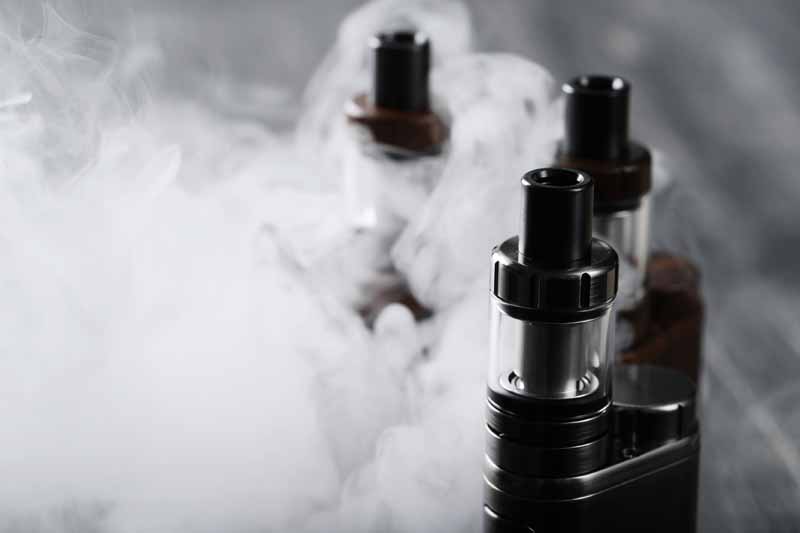Collective effort
- EVALI Regulation Science
- September 1, 2019
- 11 minutes read

Edgars Sermulis – Dreamstime.com
A recently released white paper aims to motivate U.S. Congress, the FDA and the CDC to confront the two major issues facing the vapor industry.
By Timothy S. Donahue
The industry is starting to get organized. Two major concerns facing vapor companies have brought together a varied group of 70 industry stakeholders hoping to get the U.S. Congress to confront both youth initiation and the recent outbreak of acute pulmonary disease, which has caused several deaths. Each of these concerns will have significant public and economic impacts, according to a recently released white paper by the group that represents multiple domestic and foreign vapor hardware and e-liquid manufacturers as well as more than 600 vapor retail stores covering 35 states.
“Although state health departments and the FDA have continued to link recent respiratory illnesses with illegal THC use, the [U.S. Centers for Disease Control and Prevention] CDC reports did not adequately differentiate between THC and nicotine vape even though they are completely different industries,” said Sam Salaymeh, president of AMV Holdings, one of the largest U.S. vapor retailers. “The failure of the CDC to demand THC screening of patients who refuse to admit to such use is irresponsible and dangerous. This oversight has caused widespread panic among consumers and government policymakers and negatively impacted public health.”
Salaymeh says that some vapers are going back to smoking traditional cigarettes, and there is a significant reduction in the rate of smokers who adopt nicotine vaping for harm reduction. The nicotine vapor industry is suffering “severe economic hardship,” according to Salaymeh. “We have had to shut down many stores and lay off more than 15 percent of our workforce due to the actions of drug dealers selling contaminated THC cartridges. That should not happen in a country founded on freedom and justice.”
These significant negative impacts with respect to public health are sending people back to smoking and black markets as well as the loss of potentially 80,000-plus jobs and $24 billion in industry economic output and direct political impacts, according to the paper. The group’s members collectively serve approximately one million customers a year, of which over 85 percent have used vaping to quit or substantially reduce smoking combustible cigarettes, according to the paper. Of these former smokers, the paper claims that 97.8 percent say vaping has improved their lives. None of these operators are owned by major tobacco companies.
“The consequences of the political action taken in response to these two fabrications have not been duly taken into consideration,” the paper states. “There is no evidence that [the U.S. Food and Drug Administration] FDA-regulated vapor products have resulted in any of the recent pulmonary disease-related deaths, and the overwhelming majority of the patients suffering from respiratory illness have reported the use of only THC vaping products with or without nicotine. The CDC has failed to properly distinguish illegal black market THC vaping cartridges from legally purchased nicotine-containing e-cigarettes. This oversight has caused significant consumer confusion resulting in customers returning to cigarettes and economic hardship for vape retail store operators.”
In confronting the issue of youth initiation, which the FDA claims is driven by flavored electronic nicotine-delivery system (ENDS) products, the paper states that “flavored ENDS products have existed worldwide for more than a decade. The acceleration of youth consumption only became an epidemic in the last two years along with the increased popularity of high-nicotine closed pod systems.” The paper states that Juul Labs’, the nation’s largest e-cigarette brand, growth and market penetration follow youth initiation growth patterns, and flavors are not the fundamental cause of the increase in youth uptake,.
“From a product standpoint, we believe there is ample evidence that the underlying cause for youth initiation is a combination of nicotine salts that contain high levels of nicotine and discreet devices,” the paper states. “The least important factor is nontobacco flavors. Lastly, we believe that the distribution channels of c-stores and online purchases drives youth initiation rather than the vape store channel.”
According to the paper, the group makes three data-driven, risk-based policy recommendations for regulators in response to helping curb youth initiation:
- Limit flavors to lower nicotine products sold through adult-only age-verified retailers. “Our research shows flavors are not the underlying cause of the ‘youth epidemic.’ However, flavors combined with high nicotine strengths and discreet devices can increase youth initiation. We recommend limiting flavors to lower nicotine concentrations (30 mg [per] mL and below) sold through adult-only age-verified retailers.”
- Examine nicotine strength and risk profiles. “The acceleration of youth vaping is highly correlated to the growing popularity of high nicotine concentration products, particularly 50 mg [per] mL. A nicotine level restriction has proven lower youth adoption rates in other countries where nontobacco flavors remain available. The FDA should recognize this heightened risk profile with respect to the distribution and marketing of all ENDS [products].”
- Encourage manufacturers to build age verification tools into all hardware. “Discreet devices are a powerful tool for adult consumers; however, when combined with high nicotine concentrations, they also have the youngest customer age demographic. For hardware devices commercially marketed prior to Aug. 8, 2016, we recommend the FDA waive enforcement action to allow for the addition of age verification tools. Additionally, we recommend [the] FDA waive enforcement action for pre-Aug. 8, 2016, closed pod systems marketed with a high nicotine concentration in order for the manufacturer to reduce the nicotine level. These devices should only be sold in adult-only age-verified retailer establishments.”

The CDC has not stated outright that nicotine vapor products are not the cause of the recent pulmonary health issues. However, in early October, the FDA stated that the majority of samples tested by the states or by the FDA “related to this investigation have been identified as vaping products containing THC. Through this investigation, we have also found most of the patients impacted by these illnesses reported using THC-containing products, suggesting THC vaping products play a role in the outbreak. As this complex investigation continues, we urge consumers to take heed of our warning and stop using THC vaping products and to not use vaping products of any kind that are purchased off the street or from unknown sources.”
The claim that nicotine-based ENDS products have anything to do with the pulmonary disease issue is being widely published by the national media and is supported by statements made by the CDC, which has been vague at best, according to the paper. “This claim does not differentiate between regulated nicotine vapor products and black market THC vape cartridges. It has become overwhelmingly clear that the acute pulmonary diseases and multiple fatalities are the results of vaping illegal THC cartridges and other illicit products not FDA-regulated nicotine-containing products,” the paper states. “E-cigarettes have been widely used for more than a decade, and the current cases are focused on a very narrow epidemic, both in time and geography. This suggests that these respiratory illnesses are caused by specific batches of tainted black market products and not FDA-regulated vapor products.”
As far back as August, Brian King, deputy director of research translation at the Office on Smoking and Health at the CDC, said that potential irritants include “ultrafine particulates, some heavy metals, such as lead,” and, he said, there “are also concerns about some flavorings …. We haven’t specifically linked any of those ingredients to specific cases.”
On Sept. 5, 2019, the New York Department of Health (NYDH) released an update on the pulmonary cases of New York patients. They stated that lab results found extremely high levels of vitamin E acetate in nearly all cannabis-containing samples tested as part of the investigation. “At least one vitamin E acetate-containing vape product has been linked to each patient who submitted a product for testing,” NYDH stated in a release.
In Minnesota, the Department of Health’s news release on Sept. 6, 2019, stated that of the 32 cases of reported lung illnesses under investigation, those who were interviewed all disclosed that they were vaping illicit THC products. According to the recent New England Journal of Medicine report, 85 percent of patients’ lung illness incidences were tied to black market drugs. This study delved deeper into 53 pulmonary illness cases in Illinois and Wisconsin. Of those patients, 41 were extensively interviewed, and 80 percent reported using THC products.
“By linking nicotine-based vaping and illegal black market THC vaping, the CDC has caused widespread panic among consumers who have used vaping to quit smoking cigarettes. Further, they have discouraged current smokers from transitioning to the less harmful alternative of e-cigarettes,” according to the paper.
In order to help rectify the misinformation, the group suggests that the CDC should “immediately release a public announcement further clarifying FDA-regulated vapor products are not the cause of the respiratory illnesses and deaths that it is investigating.” They also ask that the CDC publicly acknowledge Public Health England’s statement that e-cigarettes are 95 percent safer than combustible cigarettes.
Consequences of misinformation
Claiming that nicotine-based vapor products cause pulmonary illness and youth use is motivated by nontobacco flavors has caused consumer confusion and poor policy implementation, according to the paper. This has also lead to a negative public health impact and the potential loss of 80,000 jobs.
Because the CDC has refused to differentiate between nicotine vaping and THC-based vaping, the agency has created massive confusion and panic among the 13 million consumers who vape nicotine-containing e-liquids, the paper states. In addition, the CDC statement has emboldened knee-jerk state action, which will be detrimental to public health.
As for flavors, President Trump, Health and Human Services Secretary Alex Azar and acting FDA Commissioner Ned Sharpless announced the intention of the Trump administration/FDA to take action against flavored e-products in early September. In a separate announcement soon after, Sharpless announced that in the “coming weeks,” the FDA’s Center for Tobacco Products would look to clear the market of flavored e-liquid via market authorization requirements based on preliminary results from the National Youth Tobacco Survey showing continued utilization of flavored e-products by youth.
Former FDA Commissioner Scott Gottlieb stated last year that “e-cigarettes may present an important opportunity for adult smokers to transition off combustible tobacco products and onto nicotine-delivery products that may not have the same level of risks associated with them.”
Both Gottlieb and the FDA’s director of the Center for Tobacco Products, Mitch Zeller, have stated that if they can take every adult smoker and fully switch them to e-cigarettes, it would be good for public health. Since the public health announcement, daily sales for vape retail stores have decreased compared to the previous month’s sales, according to Salaymeh. “Sadly, numerous consumers have informed us that they will return to smoking cigarettes as it is now viewed as a ‘safer alternative,’” he says.

Timothy Donahue
Timothy S. Donahue is the co-founder and managing editor of Vapor Voice.
Tim spends much of his time on the road, attending conferences and interviewing industry representatives.
His networking skills, work ethic and quick mind are valuable assets to our diverse audience.